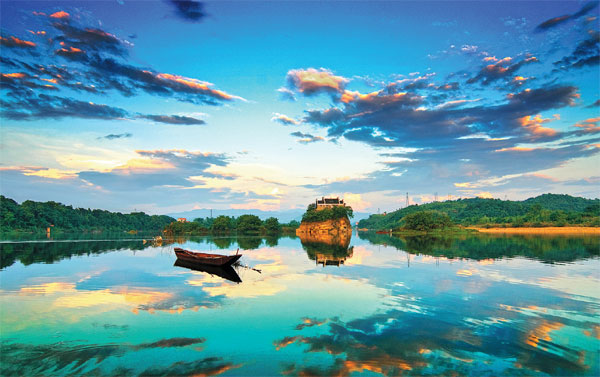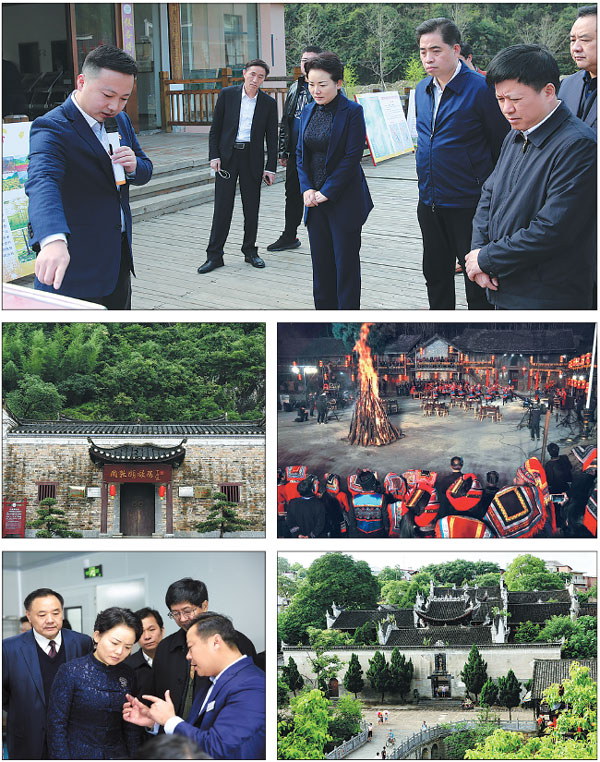Tourism booms as visitors flock to historic Yongzhou
|
Clear sky reflects on the surface of river in Xiangling Mountain, a scenic spot in Yongzhou. |
Local service industry flourishes as visitors pour in to explore great wealth of Hunan heritage and culture
Booming tourism centered on traditional Hunan province's heritage and culture has breathed new life into the historical city of Yongzhou and helped it to foster a vibrant local tourism industry.
Yongzhou, located in the south of Hunan province, has an enviable history that stretches back more than 2,100 years, and is reputed as one of the most famous and influential counties of the Han (206 BC-AD 220) and Tang (618-907) dynasties.
Because of its historical importance, Yongzhou is home to many important relics from ancient times, including the village of Shanggantang, the Lingling Zhou family courtyard and the Xintian Long family courtyard.
Popular historic sites in and around the city have led to a large increase in visitors in recent times. In 2017, more than 49 million people visited Yongzhou, generating tourism revenue of 40.67 billion yuan ($6.38 billion), an increase of 17.67 percent and 78.24 percent respectively on the previous year.
Ancient towns flourish
Attracting large numbers of visitors from both home and abroad is the village of Goulanyao in Jiangyong town, which is home to a vast number of ancient dwellings.
The biggest draw in Goulanyao is the Shuilong ancestral shrine, which is decorated with delicate and colorful frescos that are among the largest and oldest in southern China, according to Hu Binbin, a Chinese specialist in ancient towns from Central South University.
The village is popular with tourists because it takes them on a journey back in time to a period when pastoral living was the only way of life in a land surrounded by mountains and clear water, said Ouyang Mingjun, chief of Goulanyao.
He added that the stone slab road that passes through the village is the remains of the Xiaohe ancient road, one of the main travel routes that connected the central areas of China, such as Guangdong province and Guangxi Zhuang autonomous region, in ancient times.
The rise in tourism has brought with it more opportunities for local people to prosper in the service industry with many establishing homestays, restaurants and local specialty shops.
"A large number of tourists want to stay overnight in the village," Ouyang said. "We are going to build 17 wooden houses near the valley. So far, we have finished the construction of their foundations."
Investment in the local services industry has also led to the improvement in the livelihoods of many of the people living in these areas.
"We earned more than 10,000 yuan last year by selling our local snack Suozibaba cake, and we hope this year the business will be even better," said Tian Duohua, a Goulanyao local.
Creative projects
Zhou Dunyi, a famous philosopher during the Northern Song Dynasty (960-1127), was born in Daoxian county in Yongzhou. His masterpiece, Ode to the Lotus Flower, is still well known today.
Taking advantage of Daoxian county's strong association with lotus flowers, Lianxi Jinfeng Agriculture Group is building what it calls its "lotus town" project.
General manager of the company, Peng Weicheng, a Daoxian county local, said he looks forward to turning the iconic lotus into a cultural heritage asset of the county.
Lianxi Jinfeng Agriculture Group has cooperated with the local government since 2015, and the "lotus town" is beginning to take shape.
"This year we introduced more than 300 lotus varieties to the town. The lotuses will bloom from May to December. In half a month's time, the town's ponds will be filled with lotus flowers," Peng said.
"More than 27 hectares of lotus have been planted throughout the land rented from local villagers, and I will continue to expand the planting scale in the following years. This place will gather the most complete lotus varieties around the world," he added.
It's not just locals that are benefitting from Yongzhou's tourism boom, more and more investors from across the country are taking an interest, according to city officials.
The investors are being attracted by the city's wealth in unspoiled natural landscapes as well as its heritage and culture, which is another factor in why so many people are choosing to visit Yongzhou.
The city's eight national-level forest parks, four national nature reserves and eight national-level wetland parks make it one of the most ecologically diverse cities in southern China.
There are more than 3,000 species of wild animals and plants recorded in Yongzhou, which has a forest coverage of 64.7 percent - which is around 40 percentage points higher than the national average.
To exploit this natural advantage, city officials have said they are expanding the tourism industry across the board to include forest, culture, leisure, healthcare and even science tourism.
"All-for-one" tourism
Aiming to speed up the industrial transformation and upgrade in its tourism industry, Yongzhou recently released a guideline for "all-for-one" tourism.
The core value of all-for-one tourism is a partial shift from scenic spots tourism to cater to the region's growing demand for tourism products and services, said a local official.
To carry out the development plan, Yongzhou has created a route to better utilize tourism resources around its central town area, Lingling ancient town, Jiuyi Mountain, Xiaoshui River and its north, central and south regions.
Officials from the Yongzhou Tourism Foreign Affairs Bureau said that by 2020, the number of tourists arriving from home and abroad will exceed 50 million, and will generate more than 50 billion yuan in revenue.
|
Clockwise from top: Party Secretary of Yongzhou Li Hui (center) visits Tongzi'ao scenic spot in the city. The Yao ethnic group in Jianghua county celebrate at a bonfire party. Liuzi Temple in Lingling ancient town has become more and more popular among visitors. Li Hui visits an optoelectronics industrial park in Guide in the city. The former home of Zhou Dunyi, a philosopher in the Northern Song Dynasty (960-1127). Photos Provided to China Daily |
(China Daily 05/10/2018 page15)
















